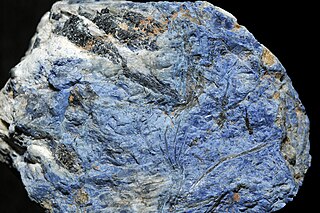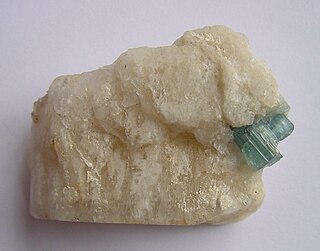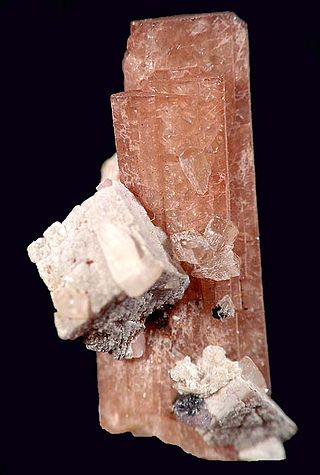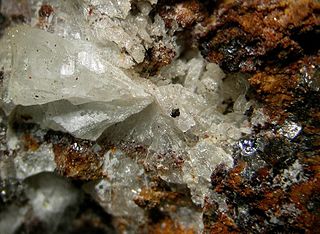
Euxenite, or euxenite-(Y), is a brownish black mineral with a metallic luster.

Samarskite is a radioactive rare earth mineral series which includes samarskite-(Y), with the chemical formula (YFe3+Fe2+U,Th,Ca)2(Nb,Ta)2O8 and samarskite-(Yb), with the chemical formula (YbFe3+)2(Nb,Ta)2O8. The formula for samarskite-(Y) is also given as (Y,Fe3+,U)(Nb,Ta)O4.

Diadochite is a phospho-sulfate mineral. It is a secondary mineral formed by the weathering and hydration of other minerals. Its formula is Fe2(PO4)(SO4)OH·5H2O. Well crystallized forms are referred to as destinezite, which has been given official recognition by the International Mineralogical Association with diadochite being the poorly formed to amorphous variety.

Dumortierite is a fibrous variably colored aluminium boro-silicate mineral, Al7BO3(SiO4)3O3. Dumortierite crystallizes in the orthorhombic system typically forming fibrous aggregates of slender prismatic crystals. The crystals are vitreous and vary in color from brown, blue, and green to more rare violet and pink. Substitution of iron and other tri-valent elements for aluminium result in the color variations. It has a Mohs hardness of 7 and a specific gravity of 3.3 to 3.4. Crystals show pleochroism from red to blue to violet. Dumortierite quartz is blue colored quartz containing abundant dumortierite inclusions.

Gahnite, ZnAl2O4, is a rare mineral belonging to the spinel group. It forms octahedral crystals which may be green, blue, yellow, brown or grey. It often forms as an alteration product of sphalerite in altered massive sulphide deposits such as at Broken Hill, Australia. Other occurrences include Falun, Sweden where it is found in pegmatites and skarns; and, in the United States, Charlemont, Massachusetts; Spruce Pine, North Carolina; White Picacho district, Arizona; Topsham, Maine; and Franklin, New Jersey.

Aenigmatite, also known as cossyrite after Cossyra, the ancient name of Pantelleria, is a sodium, iron, titanium inosilicate mineral. The chemical formula is Na2Fe2+5TiSi6O20 and its structure consists of single tetrahedral chains with a repeat unit of four and complex side branches. It forms brown to black triclinic lamellar crystals. It has Mohs hardness of 5.5 to 6 and specific gravity of 3.74 to 3.85. Aenigmatite forms a solid-solution series with wilkinsonite, Na2Fe2+4Fe3+2Si6O20.

Cerite is a complex silicate mineral group containing cerium, formula (Ce,La,Ca)
9(Mg,Fe3+
)(SiO
4)
6(SiO
3OH)(OH)
3. The cerium and lanthanum content varies with the Ce rich species and the La rich species. Analysis of a sample from the Mountain Pass carbonatite gave 35.05% Ce
2O
3 and 30.04% La
2O
3.

Beryllonite is a rare sodium beryllium phosphate mineral with formula NaBePO4. The tabular to prismatic monoclinic crystals vary from colorless to white or pale yellowish, and are transparent with a vitreous luster. Twinning is common and occurs in several forms. It exhibits perfect cleavage in one direction. The hardness is 5.5 to 6 and the specific gravity is 2.8. Refractive indices are nα = 1.552, nβ = 1.558 and nγ = 1.561. A few crystals have been cut and faceted, but, as the refractive index is no higher than that of quartz, they do not make very brilliant gemstones.

Titanowodginite is a mineral with the chemical formula MnTiTa2O8. Titanowodginite has a Mohs hardness of 5.5 and a vitreous luster. It is an iridescent dark brown to black crystal that commonly forms in a matrix of smoky quartz or white beryl in a complex zoned pegmatite.

Agrellite (NaCa2Si4O10F) is a rare triclinic inosilicate mineral with four-periodic single chains of silica tetrahedra.

Thomasclarkite-(Y) is a rare mineral which was known as UK-93 until 1997, when it was renamed in honour of Thomas H. Clark (1893–1996), McGill University professor. The mineral is one of many rare-earth element minerals from Mont Saint-Hilaire. The only reported occurrence is in an alkalic pegmatite dike in an intrusive gabbro-nepheline syenite.

The mineral zektzerite is a member of the tuhualite group and was first found in 1966 by Seattle mineralogist Benjamin Bartlett "Bart" Cannon. It was discovered in the Willow creek basin below Silver Star mountain in miarolitic cavities within the alkaline arfvedsonite granite phase of the Golden Horn batholith, Okanogan County, Washington. It is named for Jack Zektzer, mathematician and mineral collector of Seattle, Washington.

Hafnon is a hafnium nesosilicate mineral, chemical formula (Hf,Zr)SiO4 or (Hf,Zr,Th,U,Y)SiO4. In natural zircon ZrSiO4 part of the zirconium is replaced by the very similar hafnium and so natural zircon is never pure ZrSiO4. A zircon with 100% hafnium substitution can be made synthetically and is hafnon.

Ancylite is a group of hydrous strontium carbonate minerals containing cerium, lanthanum and minor amounts of other rare-earth elements. The chemical formula is Sr(Ce,La)(CO3)2(OH)·H2O with ancylite-Ce enriched in cerium and ancylite-La in lanthanum.
Altisite (IMA symbol: Ati) is an exceedingly rare alkaline titanium aluminosilicate chloride mineral with formula Na3K6Ti2Al2Si8O26Cl3, from alkaline pegmatites. It is named after its composition (ALuminium, TItanium, and SIlicon).

Danalite is an iron beryllium silicate sulfide mineral with formula: Fe2+4Be3(SiO4)3S.

Fluellite is a mineral with the chemical formula Al2(PO4)F2(OH)•7H2O. The name is from its chemical composition, being a fluate of alumine (French).

Stillwellite-(Ce) is a rare-earth boro-silicate mineral with chemical formula (Ce,La,Ca)BSiO5.
Mogovidite is a very rare mineral of the eudialyte group, with formula Na9(Ca,Na)6Ca6(Fe3+,Fe2+)2Zr3[]Si(Si9O27)2(Si3O9)2(CO3)(OH,H2O)4. The formula given is based on the original one but extended to show the presence of cyclic silicate groups. It is similar to feklichevite, differing from it in the presence of essential vacancies and carbonate group. Another specific feature is the dominance of ferric iron - a feature shared with other eudialyte-group members, including feklichevite, fengchengite, golyshevite and ikranite. Similarly to golyshevite, it is calcium-dominant, however on three sites: M(1), N(3) and N(4). It has a molecular mass of 3,066.24 gm.
Lithiophosphate is a natural form of (pure) lithium orthophosphate. It is an exceedingly rare mineral, occurring in some special types of pegmatites.

















